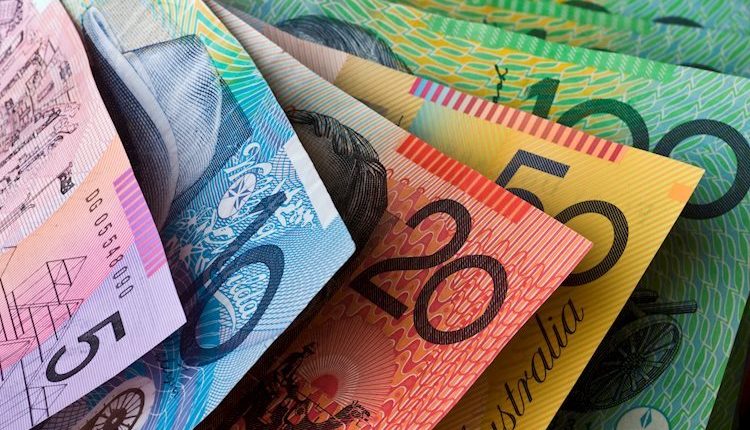- AUD/USD gains higher US Initial Jobless Claims weigh on the US Dollar.
- The US NFP data will significantly influence the Fed’s likely interest rate action in the policy meeting on December 18.
- Weak Australian Q3 GDP data has bolstered RBA dovish bets.
The AUD/USD pair ticks higher to near 0.6440 but remains trades inside Wednesday’s trading range in North American trading hours on Thursday. The Aussie pair gains slightly as the United States (US) Initial Jobless Claims data for the week ending November 29 remained higher than expected. The data showed that individuals claiming jobless benefits were 224K, higher than estimates and the prior release of 215K.
The US Dollar Index (DXY), which gauges Greenback’s value against six major currencies, slides below 106.00. The next move in the US Dollar will be projected the US Nonfarm Payrolls (NFP) data for November, which will be released on Friday.
Investors will pay close attention to the US official labor market data to get fresh cues about whether the Fed will cut interest rates again in its policy meeting on December 18. The Fed started its policy-easing cycle in September as officials were worried about deteriorating labor demand but were confident about inflation remaining on a sustainable path towards the bank’s target of 2%.
According to the CME FedWatch tool, there is a 77% chance that the Fed will reduce interest rates by 25 bps to 4.25%-4.50%, while the rest support leaving them unchanged.
The US NFP report is expected to show that the economy added 200K jobs. Economists estimate the Unemployment Rate to have accelerated to 4.2% from the former reading of 4.1%.
Meanwhile, the outlook of the Australian Dollar (AUD) has weakened as the Reserve Bank of Australia (RBA) is expected to start reducing interest rates from the April meeting next year. RBA dovish bets were bolstered by weak Australian Q3 Gross Domestic Product (GDP) data.
The near-term trend of the AUD/USD pair is bearish as the 20-day Exponential Moving Average (EMA), which trades around 0.6500 is declining.
The 14-day Relative Strength Index (RSI) slides below 40.00, suggesting a strong bearish momentum.
More downside towards the August low of 0.6348 and the round-level support of 0.6300 would appear if the Aussie breaks below Wednesday’s low of 0.6400.
On the flip side, a decisive recovery above the November 25 high of 0.6550 will drive the asset towards the round-level resistance of 0.6600, followed by the September 11 low of 0.6622.
AUD/USD daily chart
Australian Dollar FAQs
One of the most significant factors for the Australian Dollar (AUD) is the level of interest rates set by the Reserve Bank of Australia (RBA). Because Australia is a resource-rich country another key driver is the price of its biggest export, Iron Ore. The health of the Chinese economy, its largest trading partner, is a factor, as well as inflation in Australia, its growth rate and Trade Balance. Market sentiment – whether investors are taking on more risky assets (risk-on) or seeking safe-havens (risk-off) – is also a factor, with risk-on positive for AUD.
The Reserve Bank of Australia (RBA) influences the Australian Dollar (AUD) by setting the level of interest rates that Australian banks can lend to each other. This influences the level of interest rates in the economy as a whole. The main goal of the RBA is to maintain a stable inflation rate of 2-3% by adjusting interest rates up or down. Relatively high interest rates compared to other major central banks support the AUD, and the opposite for relatively low. The RBA can also use quantitative easing and tightening to influence credit conditions, with the former AUD-negative and the latter AUD-positive.
China is Australia’s largest trading partner so the health of the Chinese economy is a major influence on the value of the Australian Dollar (AUD). When the Chinese economy is doing well it purchases more raw materials, goods and services from Australia, lifting demand for the AUD, and pushing up its value. The opposite is the case when the Chinese economy is not growing as fast as expected. Positive or negative surprises in Chinese growth data, therefore, often have a direct impact on the Australian Dollar and its pairs.
Iron Ore is Australia’s largest export, accounting for $118 billion a year according to data from 2021, with China as its primary destination. The price of Iron Ore, therefore, can be a driver of the Australian Dollar. Generally, if the price of Iron Ore rises, AUD also goes up, as aggregate demand for the currency increases. The opposite is the case if the price of Iron Ore falls. Higher Iron Ore prices also tend to result in a greater likelihood of a positive Trade Balance for Australia, which is also positive of the AUD.
The Trade Balance, which is the difference between what a country earns from its exports versus what it pays for its imports, is another factor that can influence the value of the Australian Dollar. If Australia produces highly sought after exports, then its currency will gain in value purely from the surplus demand created from foreign buyers seeking to purchase its exports versus what it spends to purchase imports. Therefore, a positive net Trade Balance strengthens the AUD, with the opposite effect if the Trade Balance is negative.
Read the full article here

